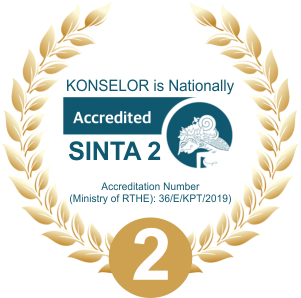Effectiveness of self management techniques to reduce truant students in middle school
 ),
), (1) Universitas Kanjuruhan Malang
 Corresponding Author
Corresponding Author
Copyright (c) 2019 Leny Latifah
DOI : https://doi.org/10.24036/0201981103804-0-00
Full Text:
 Language : en
Language : en
Abstract
Keywords
References
Alamri, N. (2015). Layanan Bimbingan Kelompok Dengan Teknik Self Management Untuk Mengurangi Perilaku Terlambat Masuk Sekolah (Studi Pada Siswa Kelas X SMA 1 Gebog Tahun 2014/2015). Jurnal Konseling GUSJIGANG, 1(1).
Asmani, J. M. (2012). Kiat Mengatasi Kenakalan Remaja di Sekolah. Yogyakarta: Buku Biru.
Baier, D. (2016). The School as an Influencing Factor of Truancy. International Journal of Criminology and Sociology, 5, 191–202.
Berenbaum, S. A., Beltz, A. M., & Corley, R. (2015). The importance of puberty for adolescent development: conceptualization and measurement. In Advances in child development and behavior (Vol. 48, pp. 53–92). Elsevier.
Briesch DuBois, J. M., Briesch, A. M., Hoffman, J. A., Struzziero, J., & Toback, R. (2017). Implementing self‐management within a group counseling context: Effects on academic enabling behaviors. Psychology in the Schools, 54(8), 852–867.
Creswell, J. W., & Creswell, J. D. (2017). Research Design: Qualitative, Quantitative, and Mixed Methods Approaches. Thousand Oaks, CA: Sage Publications.
Dahl, P. (2016). Factors associated with truancy: Emerging adults’ recollections of skipping school. Journal of Adolescent Research, 31(1), 119–138.
Fatchurahman, M., Syarif, D. F. T., & Turohmi, S. (2018). Efektivitas Layanan Konseling Kelompok Menggunakan Teknik Problem Solving dalam Menurunkan Perilaku Membolos Siswa. Indonesian Journal of Educational Counseling, 2(1), 55–68.
Febriyanti, C., & Seruni. (2015). Peran Minat dan Interaksi Siswa dengan Guru dalam Meningkatkan Hasil Belajar Matematika. Formatif: Jurnal Ilmiah Pendidikan MIPA, 4(3).
Fehér, D. J., Bartók, M., & Fehér, L. (2018). The Effects of Computer Games on Teenagers. In 2018 IEEE 12th International Symposium on Applied Computational Intelligence and Informatics (SACI) (pp. 261–266). IEEE.
Ferguson, S. G., Frandsen, M., Dunbar, M. S., & Shiffman, S. (2015). Gender and stimulus control of smoking behavior. Nicotine & Tobacco Research, 17(4), 431–437.
Jeske, D., & Axtell, C. (2017). Effort and Reward Effects: Appreciation and Self-Rated Performance in e-Internships. Social Sciences, 6(4), 154.
Lent, R. W., Ezeofor, I., Morrison, M. A., Penn, L. T., & Ireland, G. W. (2016). Applying the social cognitive model of career self-management to career exploration and decision-making. Journal of Vocational Behavior, 93, 47–57.
Nursalim, M. (2013). Strategi dan intervensi konseling. Jakarta: Akademia Permata.
Pane, A., & Dasopang, M. D. (2017). Belajar dan pembelajaran. Fitrah: Jurnal Kajian Ilmu-Ilmu Keislaman, 3(2), 333–352.
Pfefferbaum, A., Rohlfing, T., Pohl, K. M., Lane, B., Chu, W., Kwon, D., … Cummins, K. (2016). Adolescent development of cortical and white matter structure in the NCANDA sample: role of sex, ethnicity, puberty, and alcohol drinking. Cerebral Cortex, 26(10), 4101–4121.
Prasetiawan, H. (2016). Peran Bimbingan Dan Konseling Dalam Pendidikan Ramah Anak Terhadap Pembentukan Karakter Sejak Usia Dini. Jurnal CARE (Children Advisory Research and Education), 4(1), 50–60.
Sholihah, N. (2013). Penerapan Strategi Self-Management Untuk Meningkatkan Disiplin Belajar Pada Siswa Tunadaksa Cerebral Palcy Kelas IV SDLB-D YPAC Surabaya. Jurnal BK Unesa, 3(1).
Simmons, R. G. (2017). Moving into adolescence: The impact of pubertal change and school context. Routledge.
Tutiona, M. Y., Munir, A., & Ratu, B. (2016). Upaya mengurangi perilaku membolos melalui konseling individual dengan teknik behavior contract pada siswa SMP Negeri 6 Palu. Jurnal Konseling Dan Psikoedukasi, 1(1), 69–78.
Wentzel, K. R., Russell, S., & Baker, S. (2016). Emotional support and expectations from parents, teachers, and peers predict adolescent competence at school. Journal of Educational Psychology, 108(2), 242.
Wilmot, M. P., DeYoung, C. G., Stillwell, D., & Kosinski, M. (2016). Self‐monitoring and the metatraits. Journal of Personality, 84(3), 335–347.
 Article Metrics
Article Metrics
 Abstract Views : 2376 times
Abstract Views : 2376 times
 PDF Downloaded : 758 times
PDF Downloaded : 758 times
Refbacks
- There are currently no refbacks.
Copyright (c) 2019 Leny Latifah

This work is licensed under a Creative Commons Attribution 4.0 International License.







